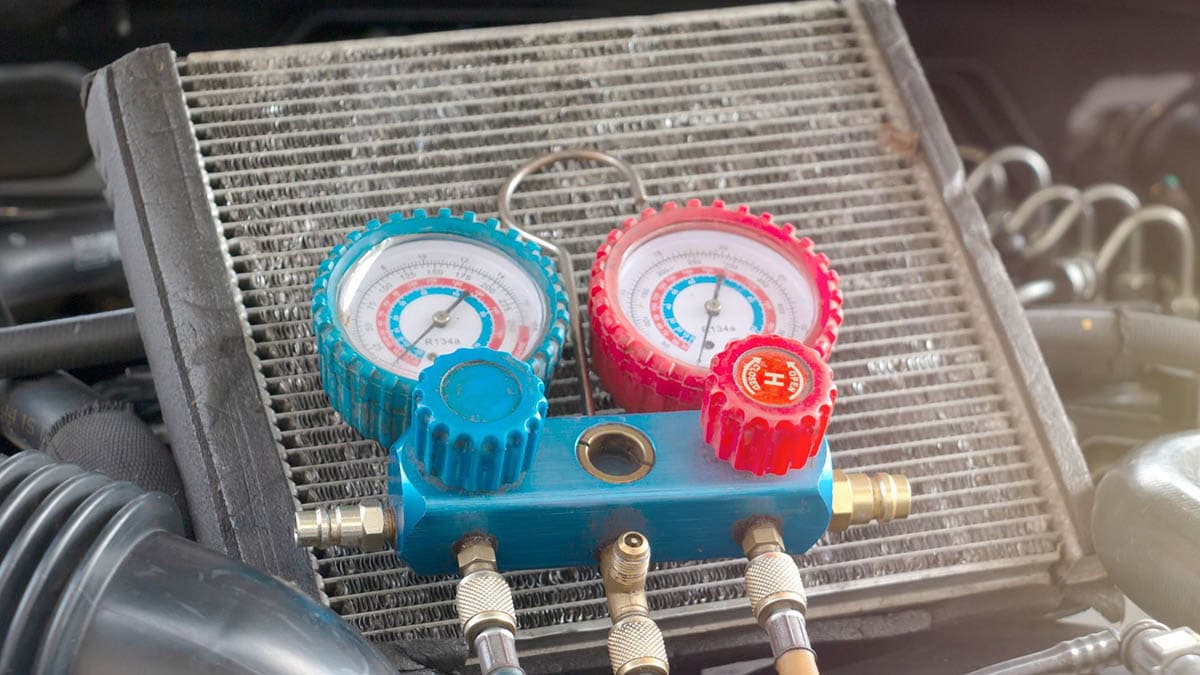It’s that time of year again when drivers’ thoughts should turn to their car’s air conditioning (AC) system. A little preventative maintenance can help stave off an AC system failure in the sweltering days of summer. A common culprit when an AC system fails is low refrigerant level. Topping off or recharging the refrigerant can breathe new life into the air conditioning system. We’ll tell you the key things you need to know including signs your AC need recharging.
What Is Auto AC Recharge?
An auto AC recharge is returning your car’s AC refrigerant to its optimum level. A car’s air conditioning is a closed system that, when engaged, creates chilled air by repeatedly turning the refrigerant from a gas to a liquid and back to gas through pressurization. For this process to be successful, a specific level of refrigerant must be maintained. Therefore, restoring the refrigerant to its optimum level is done by recharging the air conditioning system.
TIP: You will sometimes hear air conditioning refrigerant referred to as “Freon.” Freon, like Kleenex, is a brand name for a hydrochlorofluorocarbon (HCFC) refrigerant used in car AC systems for decades. It is now banned by the Environmental Protection Agency (EPA).
RELATED: Freon: Signs Your Car Needs It
What Are the Signs a Car’s AC Needs Recharging?
Some telltale signs your refrigerant level may be low are:
- AC system isn’t cooling.
- Ice or frost on the lines or compressor.
- You can’t hear the AC unit kick on.
- Greasy puddles form under your parked car.
- Warm air coming out of the vents.
TIP: Even if your car’s AC isn’t exhibiting any of the telltale signs of low refrigerant, you can check the level yourself with a refrigerant test gauge. However, you need to know the specific class of AC refrigerant your vehicle uses (R12, R134a, or R1234yf) because they aren’t interchangeable. You can find this info in your car owner’s manual, on a sticker under the hood, or by contacting a dealer’s service department for your brand or car repair shop.
How Much Does an AC Recharge Cost?
According to Kelley Blue Book’s Service Advisor pricing tool for auto repairs, getting a car’s AC unit charged professionally carries a price tag of $264-$310. However, checking for refrigerant leaks is typically part of a professional recharging process.
Can You Recharge a Car’s AC System Yourself?
The quick answer is, yes, you can recharge a car’s air conditioning system yourself. However, there is a degree of danger to you and the environment. Before attempting the recharge, put on gloves and safety goggles. Furthermore, you need to know the class of refrigerant your car uses, buy the correct replacement refrigerant, and perhaps purchase the appropriate charge hose and gauge kit. You also must be able to identify your car’s air conditioning compressor to ensure it’s operating, as well as locating the AC system’s low-pressure port on the return line. That’s where you attach the recharge hose, gauge, and can of refrigerant. Recharging yourself will set you back between $80 and $130.
TIP: According to Kelley Blue Book’s Gary Hardesty, our in-house service and maintenance expert and an A.S.E. certified master technician, a low refrigerant level nearly always signals a leak somewhere in your car AC’s system. Although recharging with fresh refrigerant may temporarily restore the AC’s cooling capability, it won’t solve most leak issues. “It’s important to address the leak both as a cost measure and an environmental concern with the release of refrigerant into the atmosphere,” Hardesty said, while adding, “There are some legal and operational concerns with doing repairs to the (car’s) AC at home.”
Our Advice
If the loss of refrigerant is a chronic, ongoing issue, have your car’s AC system serviced by a professional technician at a dealership or repair shop. Keeping your vehicle in solid working order helps retain its value. By maintaining your vehicle, it helps if you ever need to sell or trade it in for a new one.





